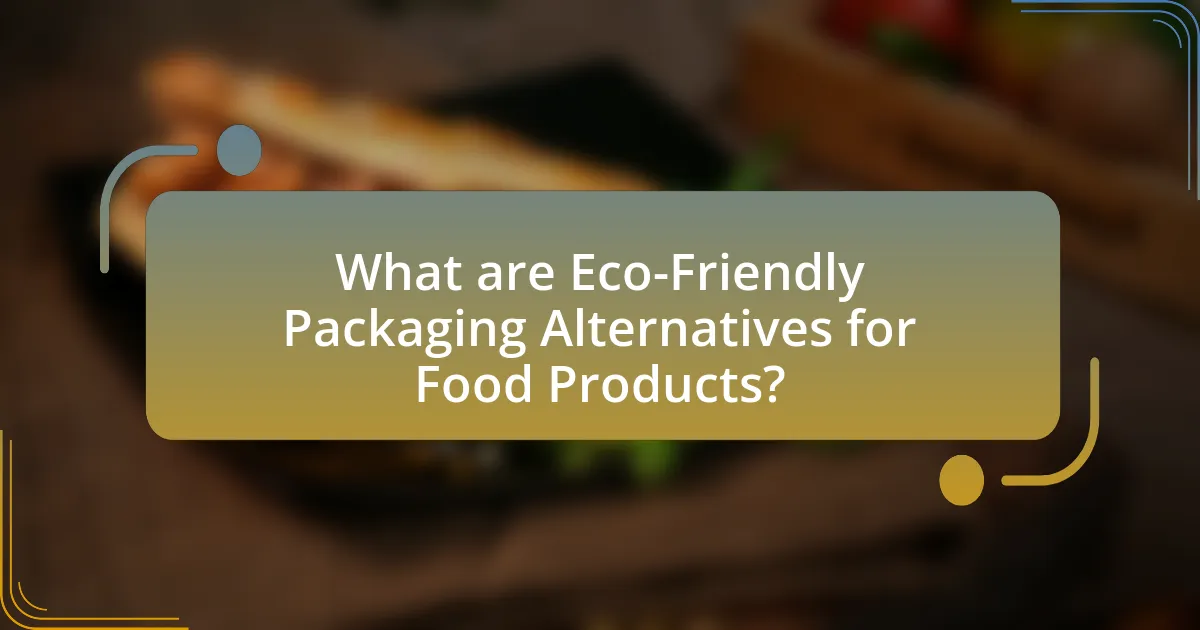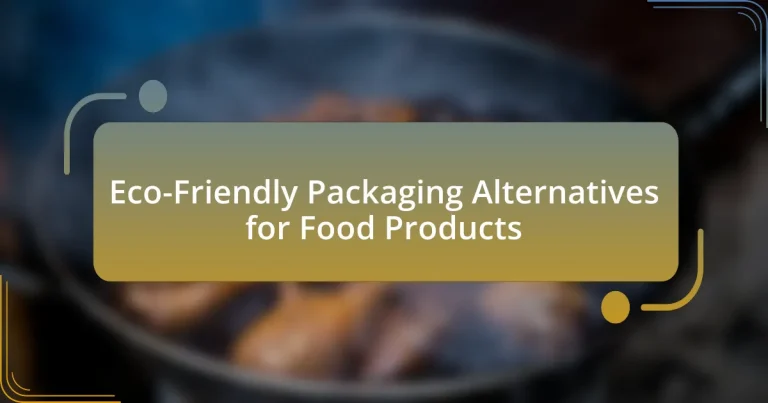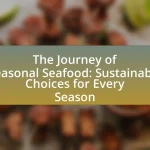Eco-friendly packaging alternatives for food products encompass biodegradable materials, compostable packaging, and reusable containers, all aimed at reducing environmental impact. These alternatives help mitigate issues associated with traditional packaging, such as plastic pollution and resource depletion, while promoting sustainability. The article explores the importance of eco-friendly packaging, the various materials used, and the benefits they offer in terms of food safety and freshness. Additionally, it addresses the challenges manufacturers face in adopting these alternatives, consumer perceptions, and the innovations shaping the future of sustainable packaging solutions.

What are Eco-Friendly Packaging Alternatives for Food Products?
Eco-friendly packaging alternatives for food products include biodegradable materials, compostable packaging, and reusable containers. Biodegradable materials, such as plant-based plastics made from cornstarch or sugarcane, break down naturally over time, reducing landfill waste. Compostable packaging, like those made from paper or certain bioplastics, can decompose in composting facilities, returning nutrients to the soil. Reusable containers, such as glass jars or stainless steel containers, minimize single-use waste and can be used multiple times, promoting sustainability. According to a study by the Ellen MacArthur Foundation, transitioning to biodegradable and compostable materials could significantly reduce plastic pollution in the environment.
Why is eco-friendly packaging important for food products?
Eco-friendly packaging is important for food products because it reduces environmental impact and promotes sustainability. Traditional packaging often contributes to pollution and waste, whereas eco-friendly options, such as biodegradable materials, minimize landfill contributions and lower carbon footprints. According to a study by the Ellen MacArthur Foundation, transitioning to sustainable packaging could reduce global plastic waste by 80% by 2040. This shift not only benefits the environment but also meets consumer demand for responsible practices, as 72% of consumers prefer brands that use sustainable packaging.
What environmental issues are associated with traditional packaging?
Traditional packaging is associated with several environmental issues, primarily plastic pollution, resource depletion, and greenhouse gas emissions. Plastic packaging contributes significantly to ocean pollution, with an estimated 8 million tons entering the oceans annually, harming marine life and ecosystems. Additionally, traditional packaging often relies on non-renewable resources, such as petroleum, leading to depletion of these resources and increased environmental degradation. The production and disposal of traditional packaging materials also generate substantial greenhouse gas emissions; for instance, the manufacturing of plastic emits approximately 3.8 billion metric tons of CO2 equivalent each year. These factors collectively highlight the detrimental impact of traditional packaging on the environment.
How does eco-friendly packaging contribute to sustainability?
Eco-friendly packaging contributes to sustainability by reducing environmental impact through the use of biodegradable, recyclable, or compostable materials. These materials minimize waste in landfills and decrease pollution, as they break down naturally over time, unlike traditional plastics that can take hundreds of years to decompose. For instance, a study published in the journal “Waste Management” found that biodegradable packaging can reduce greenhouse gas emissions by up to 50% compared to conventional packaging. Additionally, eco-friendly packaging often requires less energy to produce, further lowering its carbon footprint and promoting resource conservation.
What types of eco-friendly packaging alternatives exist?
Eco-friendly packaging alternatives include biodegradable materials, compostable packaging, recycled paper and cardboard, plant-based plastics, and reusable containers. Biodegradable materials, such as polylactic acid (PLA), break down naturally over time, reducing landfill waste. Compostable packaging, made from organic materials, can decompose in composting facilities, enriching soil. Recycled paper and cardboard utilize post-consumer waste, minimizing the need for virgin resources. Plant-based plastics, derived from renewable resources like corn or sugarcane, offer a sustainable alternative to traditional petroleum-based plastics. Reusable containers, such as glass or stainless steel, significantly reduce single-use packaging waste. These alternatives collectively contribute to a more sustainable packaging ecosystem, aligning with environmental conservation efforts.
What materials are commonly used in eco-friendly food packaging?
Common materials used in eco-friendly food packaging include biodegradable plastics, recycled paper, glass, and plant-based materials such as cornstarch and bamboo. Biodegradable plastics, made from renewable resources, decompose more quickly than traditional plastics, reducing environmental impact. Recycled paper is widely utilized due to its ability to be repurposed multiple times, minimizing waste. Glass is recyclable and can be reused indefinitely without loss of quality. Plant-based materials, like cornstarch and bamboo, are sustainable alternatives that break down naturally, further supporting eco-friendly practices. These materials collectively contribute to reducing pollution and conserving resources in food packaging.
How do biodegradable and compostable options differ?
Biodegradable options break down into natural elements over time through the action of microorganisms, while compostable options specifically decompose into nutrient-rich compost under controlled conditions within a specific timeframe. Biodegradable materials can take varying amounts of time to decompose, depending on environmental factors, whereas compostable materials must meet specific standards, such as ASTM D6400 or EN 13432, to ensure they break down within 90 to 180 days in a composting environment. This distinction is crucial for waste management and environmental impact, as compostable materials contribute to soil health, while biodegradable materials may not always do so effectively.
How do eco-friendly packaging alternatives impact food safety?
Eco-friendly packaging alternatives can positively impact food safety by reducing the risk of chemical contamination and enhancing biodegradability. Materials such as plant-based plastics and recycled paper do not leach harmful substances into food, unlike some traditional plastics that may contain BPA or phthalates. Research indicates that biodegradable packaging can also reduce the growth of harmful bacteria due to its natural antimicrobial properties, as seen in studies published in the Journal of Food Science. These alternatives not only maintain food integrity but also contribute to environmental sustainability, aligning food safety with ecological responsibility.
What regulations govern the use of eco-friendly materials in food packaging?
The regulations governing the use of eco-friendly materials in food packaging primarily include the Food and Drug Administration (FDA) guidelines in the United States, which ensure that materials are safe for food contact. Additionally, the European Union has established the Framework Regulation (EC) No. 1935/2004, which mandates that materials intended to come into contact with food must not transfer constituents to food in quantities that could endanger human health. These regulations are supported by specific directives such as the Plastics Regulation (EU) No. 10/2011, which outlines the requirements for plastic materials and articles intended for food contact. Compliance with these regulations is essential for manufacturers to ensure that eco-friendly materials are both safe and effective for food packaging.
How do these alternatives maintain food freshness and quality?
Eco-friendly packaging alternatives maintain food freshness and quality through the use of biodegradable materials that provide effective barriers against moisture, oxygen, and light. These materials, such as plant-based plastics and compostable films, help to slow down the degradation process of food by minimizing exposure to environmental factors that cause spoilage. For instance, studies have shown that packaging made from polylactic acid (PLA) can extend the shelf life of perishable items by up to 50% compared to traditional plastic. Additionally, some eco-friendly options incorporate natural preservatives or antimicrobial agents derived from plants, further enhancing their ability to preserve food quality.
What are the challenges of adopting eco-friendly packaging?
The challenges of adopting eco-friendly packaging include higher costs, limited availability of materials, and consumer acceptance issues. Higher costs arise because sustainable materials often require more expensive production processes compared to conventional packaging. Limited availability of eco-friendly materials can hinder manufacturers’ ability to source suitable options, as many suppliers may not offer a wide range of sustainable alternatives. Additionally, consumer acceptance issues can occur when customers are unfamiliar with or skeptical about the effectiveness and benefits of eco-friendly packaging, which can affect purchasing decisions. These challenges are supported by industry reports indicating that while demand for sustainable packaging is growing, the transition remains complex due to these barriers.
What are the cost implications for manufacturers?
The cost implications for manufacturers adopting eco-friendly packaging alternatives include increased material costs and potential savings in waste management. Eco-friendly materials, such as biodegradable plastics or recycled paper, often have higher production costs compared to traditional packaging. For instance, a study by Smithers Pira indicates that sustainable packaging can cost 10-30% more than conventional options. However, manufacturers may experience long-term savings through reduced waste disposal fees and improved brand loyalty, as consumers increasingly prefer environmentally responsible products. This dual impact highlights the financial considerations manufacturers must evaluate when transitioning to eco-friendly packaging solutions.
How do consumer perceptions affect the adoption of eco-friendly packaging?
Consumer perceptions significantly influence the adoption of eco-friendly packaging by shaping their willingness to choose sustainable options over conventional ones. Positive perceptions, such as the belief that eco-friendly packaging is healthier or more environmentally responsible, can lead to increased demand for products using such materials. Research indicates that 66% of consumers are willing to pay more for sustainable brands, highlighting the impact of consumer attitudes on market trends. Conversely, negative perceptions, such as doubts about the effectiveness or quality of eco-friendly packaging, can hinder its acceptance. Therefore, addressing consumer concerns and enhancing awareness about the benefits of eco-friendly packaging is crucial for its widespread adoption.
What innovations are shaping the future of eco-friendly packaging?
Innovations shaping the future of eco-friendly packaging include biodegradable materials, plant-based plastics, and reusable packaging systems. Biodegradable materials, such as those derived from cornstarch or mushroom mycelium, decompose naturally, reducing landfill waste. Plant-based plastics, made from renewable resources like sugarcane, offer a sustainable alternative to traditional petroleum-based plastics, with some products designed to break down in industrial composting facilities. Reusable packaging systems, exemplified by companies implementing deposit return schemes, encourage consumers to return containers for reuse, significantly minimizing single-use waste. These innovations collectively contribute to a more sustainable packaging landscape, addressing environmental concerns associated with conventional packaging methods.
How is technology advancing eco-friendly packaging solutions?
Technology is advancing eco-friendly packaging solutions through innovations such as biodegradable materials, smart packaging, and recycling technologies. Biodegradable materials, like polylactic acid (PLA) derived from corn starch, decompose more quickly than traditional plastics, reducing landfill waste. Smart packaging incorporates sensors to monitor freshness, thereby minimizing food waste and extending shelf life. Additionally, advancements in recycling technologies, such as chemical recycling, allow for the breakdown of plastics into their original monomers, enabling the creation of new products from recycled materials. These developments collectively contribute to a more sustainable packaging ecosystem, addressing environmental concerns associated with conventional packaging methods.
What role do startups play in developing new packaging alternatives?
Startups play a crucial role in developing new packaging alternatives by driving innovation and introducing sustainable materials and technologies. These companies often focus on eco-friendly solutions that address environmental concerns, such as reducing plastic waste and utilizing biodegradable materials. For instance, startups like Loliware and Ecovative Design have pioneered edible cups and mycelium-based packaging, respectively, showcasing how new entrants can disrupt traditional packaging methods. Their agility allows them to experiment with novel ideas and respond quickly to market demands, often leading to breakthroughs that larger corporations may overlook.
What best practices can businesses follow when transitioning to eco-friendly packaging?
Businesses transitioning to eco-friendly packaging should prioritize the use of sustainable materials, such as biodegradable, compostable, or recyclable options. This approach reduces environmental impact and aligns with consumer demand for greener products. For instance, a study by the Ellen MacArthur Foundation highlights that switching to biodegradable materials can significantly decrease plastic waste in landfills and oceans. Additionally, companies should conduct a lifecycle assessment to evaluate the environmental effects of packaging choices, ensuring that the selected materials minimize carbon footprint throughout their lifecycle. Implementing these best practices not only enhances brand reputation but also meets regulatory requirements and consumer expectations for sustainability.
How can companies effectively communicate their packaging choices to consumers?
Companies can effectively communicate their packaging choices to consumers by utilizing clear labeling, educational marketing, and transparency about materials used. Clear labeling on packaging that highlights eco-friendly attributes, such as recyclable or biodegradable symbols, helps consumers quickly identify sustainable options. Educational marketing campaigns can inform consumers about the benefits of these choices, such as reduced environmental impact, which can enhance brand loyalty. Transparency regarding sourcing and production processes, supported by certifications from recognized environmental organizations, builds trust and credibility. For instance, a study by the Nielsen Global Corporate Sustainability Report found that 66% of consumers are willing to pay more for sustainable brands, indicating the importance of effective communication in influencing purchasing decisions.
What steps should businesses take to evaluate their packaging options?
Businesses should take the following steps to evaluate their packaging options: first, assess the environmental impact of current packaging materials by analyzing their lifecycle, including production, transportation, and disposal. Next, research eco-friendly alternatives such as biodegradable, compostable, or recyclable materials that align with sustainability goals. Additionally, conduct cost analysis to compare the financial implications of switching to eco-friendly packaging versus traditional options. Finally, gather consumer feedback to understand preferences and perceptions regarding packaging choices, ensuring that the selected options resonate with target audiences. This structured approach enables businesses to make informed decisions that balance environmental responsibility with economic viability.


